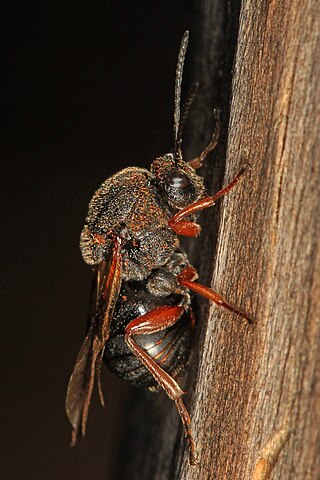
Gall wasps, also traditionally calledgallflies, are hymenopterans of the family Cynipidae in the wasp superfamily Cynipoidea. Their common name comes from the galls they induce on plants for larval development. About 1,300 species of this generally very small creature are known worldwide, with about 360 species of 36 different genera in Europe and some 800 species in North America.

Oak apple or oak gall is the common name for a large, round, vaguely apple-like gall commonly found on many species of oak. Oak apples range in size from 2 to 4 centimetres in diameter and are caused by chemicals injected by the larva of certain kinds of gall wasp in the family Cynipidae.
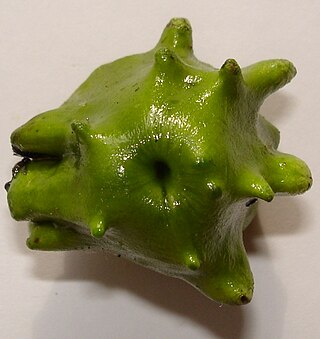
Andricus quercuscalicis is a gall wasp species inducing knopper galls.

Andricus kollari, also known as the marble gall wasp, is a parthenogenetic species of wasp which causes the formation of marble galls on oak trees. Synonyms for the species include Cynips kollari, Andricus quercusgemmae, A. minor, A. indigenus and A. circulans.
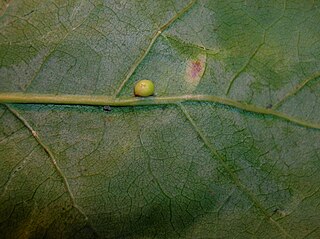
Neuroterus anthracinus is a widely distributed gall wasp that forms chemically induced leaf galls on oak trees. N. anthracinus has both sexual and agamic generations and in consequence forms two distinct galls, the oyster gall and April-bud gall.

Andricus is a genus of oak gall wasps in the family Cynipidae.
Vitula lugubrella is a species of snout moth in the genus Vitula. It was described by Émile Louis Ragonot in 1887. It is found in North America, including California.

Cynipini is a tribe of gall wasps. These insects induce galls in plants of the beech and oak family, Fagaceae. They are known commonly as the oak gall wasps. It is the largest cynipid tribe, with about 936 to 1000 recognized species, most of which are associated with oaks. The tribe is mainly native to the Holarctic. Cynipini wasps can act as ecosystem engineers. Their galls can become hosts of inquilines, and the wasps themselves are hosts to parasitoids.

Andricus quercuscalifornicus, or the California gall wasp, is a small wasp species that induces oak apple galls on white oaks, primarily the valley oak but also other species such as Quercus berberidifolia. The California gall wasp is considered an ecosystem engineer, capable of manipulating the growth of galls for their own development. It is found from Washington, Oregon, and California to northern regions of Mexico. Often multiple wasps in different life stages occupy the same gall. The induced galls help establish complex insect communities, promoting the diversification in niche differentiation. Furthermore, the adaptive value of these galls could be attributed their ecological benefits such as nutrition, provision of microenvironment, and enemy avoidance.

Atrusca is a genus of gall wasps in the family Cynipidae. It consists of approximately 50 species, and is found in North and Central America.

Amphibolips is an American genus of gall wasps in the family Cynipidae. There are about 57 described species in the genus Amphibolips with several others still undescribed.

Disholcaspis is a genus of gall wasps in the family Cynipidae. There are more than 40 species described in the genus Disholcaspis. Some Disholcaspis species induce galls that produce honeydew, a sweet liquid that attracts yellow jackets, ants, and bees. These insects then protect the galls from parasitic wasps.

Amphibolips quercusinanis, known generally as the larger empty oak apple wasp, is a species of gall wasp in the family Cynipidae.

Callirhytis is a genus of gall wasps in the family Cynipidae. There are more than 90 described species in Callirhytis. Wasps in this genus primarily induce wasps on oak trees in North America.

Philonix is a genus of oak gall wasps in the family Cynipidae. Species in this genus are only known from Canada, the United States, and Mexico. The larvae of Philonix wasps induce galls on white oaks that are typically spherical, soft and fleshy. Galls are usually formed on the underside of leaves. Adult wasps are similar in appearance to species in the genus Acraspis. Many gall wasps have alternate sexual and asexual generations, but this has not been documented in Philonix.
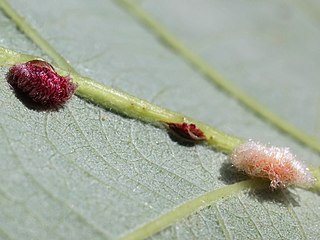
Druon ignotum is a species of gall wasp in the family Cynipidae.
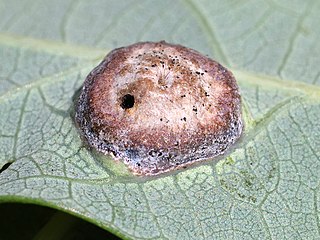
Callirhytis quercusfutilis, the oak wart gall wasp, is a species of gall wasp in the family Cynipidae.
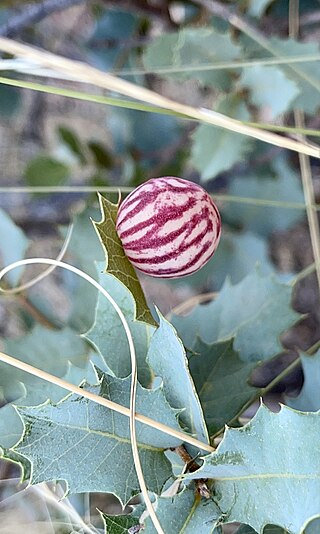
Atrusca capronae, also known as the striped oak-apple gall wasp, is a fairly common species of cynipid wasp that produces galls on oak trees in North America. The wasp oviposits on shrub live oak leaves. The intensity of the stripe color may vary regionally. This wasp is most commonly observed in Arizona but is found elsewhere in southwestern North America where its host plant is present.
Atrusca bella, also known as the little oak-apple gall wasp, is a locally common species of cynipid wasp that produces galls on oak trees in North America. The wasp oviposits on Arizona white oak, Mexican blue oak, netleaf oak, Toumey oak, and shrub live oak. The larval chamber is at the center of the gall, connected to the husk by slender, radiating fibers. The gall induced by this wasp is larger, lighter-colored, and more common than the similar gall induced by Atrusca brevipennata. This wasp has been observed in Arizona and New Mexico.
















